
FITT Principle for Flexibility and Warming Up - Glencoe/McGraw-Hill
Static stretches of warm muscles; 20?60 seconds, three sets. T Type of Exercise. Which Exercises. After warm-up: dynamic stretch, prepares body for exercise.
adsPart of the document
Type of ExerciseWhich Exercises
After warm-up: dynamic stretch, prepares body for exercise
After cooldown: static stretch, most improvement gains for flexibility
The most significant influence on your flexibility is an active or inactive lifestyle. As you increase or continue your physical activity, your muscles
and connective tissues stay elastic. If you decrease your physical activity,
your muscles and connective tissues lose elasticity. If you remain inactive,
you will also add body fat, which further limits flexibility. A moderate to
high level of flexibility is important for efficient physical movement. You
need to stretch a minimum of two to three times a week.
The balance between muscular strength and flexibility is very important. If you have muscle imbalance, a condition in which one muscle group
becomes too strong in relation to a complementary group, you are more
prone to pain or injury. This may also occur in someone who is hyper-
flexible, which is an excessive amount of flexibility.
Note: Stretching should not be painful. Pain means something is wrong!FITT Principle for Warming Up
Stretching is not warming up. It is an important part of warming up,
however. Warming up is literally the process of warming up your core body
temperature.
It is very important that you perform the general warm-up before you
stretch. Cold muscles do not stretch very well, so it is not a good idea to
attempt to stretch before your muscles are warm. Warm muscles that are stretched are less likely to be injured.
FITT Principle for Flexibility and
Warming Up


